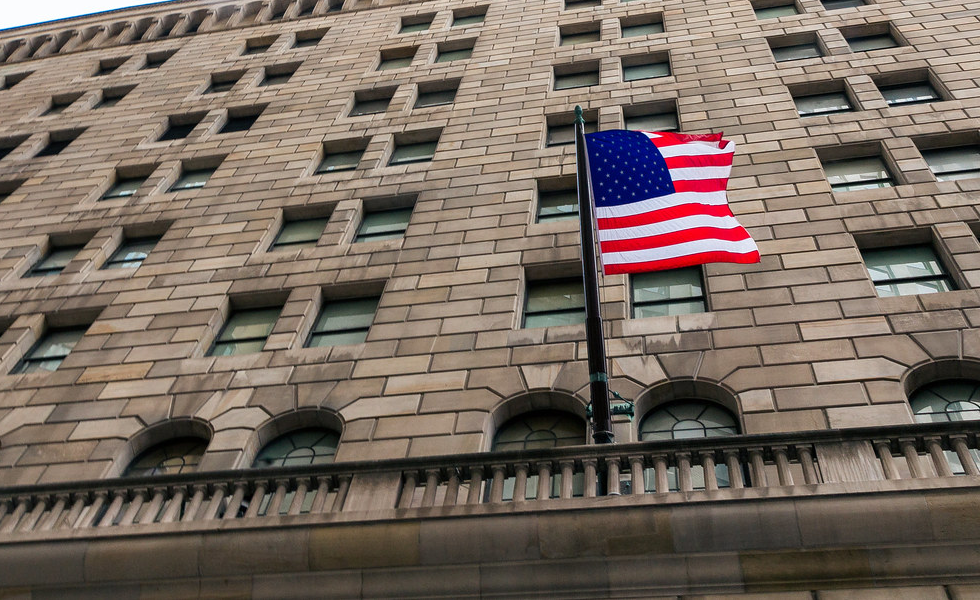BlueBay AM: Economy will continue to boom and Fed will follow the data

Mark Dowding, CIO at BlueBay Asset Management, has issued his latest market commentary. This week he focusses on the Fed, potential rises in interest rates and growing inflation concerns.
This week’s Federal Reserve (Fed) meeting provided a focal point for markets, with the FOMC adjusting its language to suggest that it may be closer to a change in policy than previously suggested. Since the previous meeting in April, we have witnessed two inflation reports that have been well above consensus estimates.
Although Powell reiterated the view that much of this upward move in prices reflected transitory effects linked to the re-opening of the economy, he communicated there was a degree of uncertainty surrounding this, with risks to inflation projections tilted to the upside.
We continue to believe that the broader market remains overly complacent with respect to US inflation and that core CPI may remain elevated in the months ahead. We also believe that demand for labour is likely to lift jobs growth and wages in the months to come, especially as additional benefits to unemployed workers begin to dry up.
US rates
Consequently, we retain our view that the Fed will commence its taper discussions at the Jackson Hole meeting in August, leading to a taper announcement at the September FOMC. We would also expect two or three Fed members to bring forward rate-hike expectations by a number of months, such that the dot plot evolves to price a first hike at the end of 2022 and a total of three hikes by the end of 2023.
US yields moved higher following the Fed meeting, but thereafter have fallen as the curve has flattened in something of a pre-taper tantrum, which has also seen a reversal of other reflationary trades in commodities and other assets.
In some respects, a more dovish Fed should mean a steeper curve and a more hawkish Fed a flatter curve. Therefore, part of this move seems logical. However, it seems wrong, in our view, to conclude that the economic backdrop has changed and equally wrong to think that the Fed has fundamentally changed its policy framework. The AIT approach remains intact, as does robust economic growth.
However, such a framework implies that the Fed will react to data (rather than pre-empting it) and so it makes perfect sense that the Fed should be adjusting its narrative somewhat following incoming information. Notwithstanding market sentiment in the short term, we remain confident that it will be data that drives policy and that the incoming data is set to remain robust in the period ahead of us.
In this context, we believe there is scope to make gains through short positions in US rates, with the outlook for yields skewed to the upside. In the wake of the Fed meeting, we think that 10-year yields may return to the middle of the 1.50%–1.75% range that has largely held since the end of Q1. A move beyond the top end of this range may require further confirmation in data, which could come in terms of a stronger US jobs report at the start of July.
That said, with the Fed continuing to purchase USD120bn of securities every month, financial conditions are set to remain accommodative for some time.
From that point of view, whilst risk assets may rightly fear an inflection point in the monetary policy cycle, broad conditions remain supportive for the time being and it may be inappropriate to adopt an overly bearish stance on risk in general, with the outlook for growth and earnings set to remain constructive.
Fed communication has also seen the US dollar appreciating versus other global currencies and we think there is scope for the greenback to make further gains if our view on the economy is validated by data. Covid-related newsflow also favours the US on a relative basis. The US economy has managed to fully reopen during the past several weeks, with mask mandates scrapped and capacity limits lifted as infection rates continue to fall.
UK
In contrast to the US, the UK has seen numbers moving in the wrong direction, notwithstanding high vaccination rates, as it battles with the Delta variant. This has caused the UK government pause in lifting remaining restrictions and there is fear that the situation may not be much better by the next review date, 19 July.
Consequently, we believe that the pound could come under pressure versus the dollar in weeks to come, with the added risk of Brexit-related trade disputes flaring up with the Continent.
In the EU, we would caution that lower vaccination rates could leave countries exposed to a Delta variant wave in the coming weeks; divergent trends could lead to bigger FX moves in the period ahead.
Europe
Bund yields largely took their lead from US Treasuries over the past week. Issuance from the Next Generation EU programme was well received (even if the deal itself seemed poorly managed by a number of banks, in our opinion). We look for NGEU to represent a new risk-free asset in the eurozone to ultimately rival Bunds.
At the same time, upcoming regional elections in France serve as a reminder of political risk events at a single-country level. In France, there is a risk that the far right could win a significant number of regions and this may infer a close race in the upcoming Presidential election, with Marine Le Pen appearing to poll relatively close to Macron.
We see limited risk in this year’s German elections, but the French and Italian votes that follow in 2022 and 2023 could represent a renewed test of EU solidarity.
Credit
Corporate credit markets remain relatively well supported by ongoing investor demand. Issuance is broadly elevated, though absent a sharper correction in stocks it seems that the prospects for firmer growth and improving earnings remain supportive of credit quality. In commodities, there has been some cooling in prices such as lumber and copper, which have been subject to speculative pressure in past months.
Looking ahead
It seems that the outlook for the US economy and monetary policy will continue to dominate investors thoughts. Analysis on the ground in the US seems to point to a booming economy, with issues such as shortages in childcare provision being a factor holding back the labour market and forcing employers to compete for talent, by raising wages and increasing benefits packages to workers.
Fiscal and monetary policy remain stimulative and with pent-up demand leading to increasing output, we see little to hold the economy back in the months ahead – even if the pace of expansion will inevitably cool from the 10% growth rate witnessed in the current calendar quarter. We think that the economy will have returned to full employment by the end of this year. Meanwhile, our analysis of survey data sees core inflation close to 4% over the next few months and staying above 3% for the year to come.
This being the case, we wonder whether the Fed may need to reassess the amount of stimulus it has delivered since the onset of Covid. The risk from over-stimulating looked very low this time last year. Given the unprecedented and uncertain nature of the pandemic, this meant that it was clearly appropriate that the Fed should commit to do ‘whatever was necessary’ to stimulate and facilitate economic recovery.
However, as the outlook normalises it may be time to reassess whether the calibration of stimulus was perhaps bigger than was actually required. Thus, it may be appropriate to draw back in order to ensure that it does not need to tighten policy too aggressively at a later point in time, should stimulus eventually lead to economic overheating. In many respects, in 2020 the FOMC, like a golfer facing a scary hazard, went big, throwing everything at the problem.
But the return of greed over fear – be this in parts of the stock market, crypto currencies or digital non-fungible tokens – may suggest that the Fed went too big and that it may need to draw back in the weeks to come.
In that context, we feel that the Fed will take its cue from the data and therefore markets should be more attentive to upcoming releases. Markets have enjoyed the Fed money printing machine going ‘brrrr’ (per the memes in the Reddit chat forums) and may be unhappy if this is turned off. However, the Fed has a job to fulfil its mandate, not just make investors happy. This may become increasingly apparent later in the summer.







